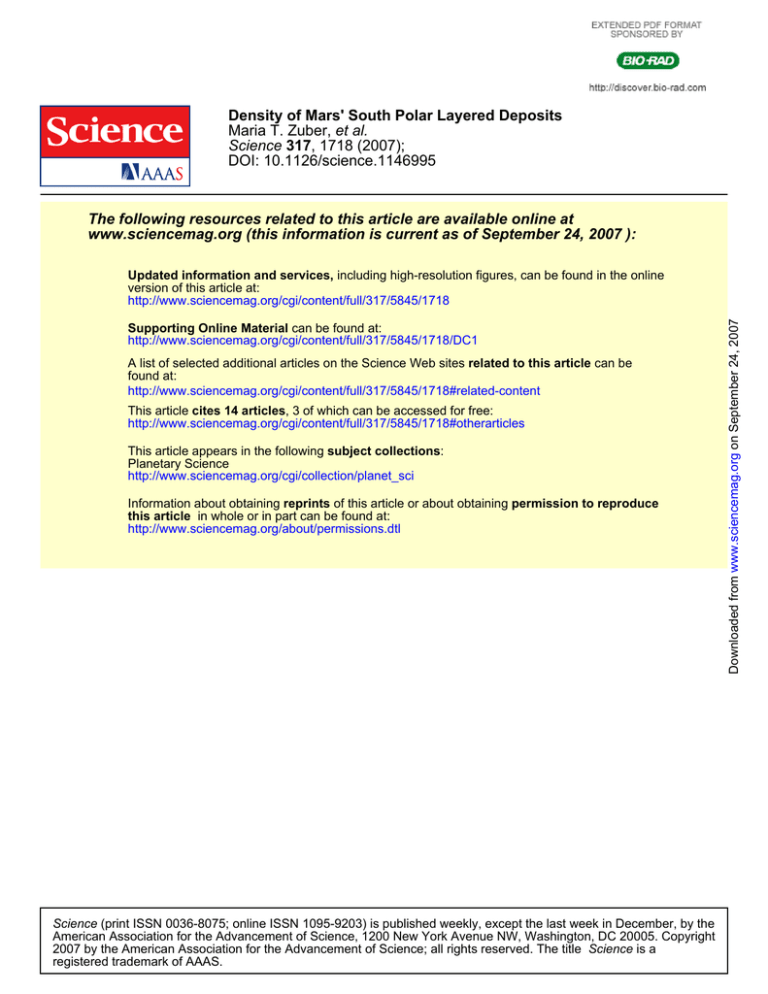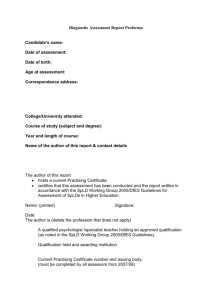Maria T. Zuber, , 1718 (2007); DOI: 10.1126/science.1146995
advertisement

Density of Mars' South Polar Layered Deposits Maria T. Zuber, et al. Science 317, 1718 (2007); DOI: 10.1126/science.1146995 The following resources related to this article are available online at www.sciencemag.org (this information is current as of September 24, 2007 ): Supporting Online Material can be found at: http://www.sciencemag.org/cgi/content/full/317/5845/1718/DC1 A list of selected additional articles on the Science Web sites related to this article can be found at: http://www.sciencemag.org/cgi/content/full/317/5845/1718#related-content This article cites 14 articles, 3 of which can be accessed for free: http://www.sciencemag.org/cgi/content/full/317/5845/1718#otherarticles This article appears in the following subject collections: Planetary Science http://www.sciencemag.org/cgi/collection/planet_sci Information about obtaining reprints of this article or about obtaining permission to reproduce this article in whole or in part can be found at: http://www.sciencemag.org/about/permissions.dtl Science (print ISSN 0036-8075; online ISSN 1095-9203) is published weekly, except the last week in December, by the American Association for the Advancement of Science, 1200 New York Avenue NW, Washington, DC 20005. Copyright 2007 by the American Association for the Advancement of Science; all rights reserved. The title Science is a registered trademark of AAAS. Downloaded from www.sciencemag.org on September 24, 2007 Updated information and services, including high-resolution figures, can be found in the online version of this article at: http://www.sciencemag.org/cgi/content/full/317/5845/1718 the angled package to the present horizontal surface as result of erosion. Despite the age uncertainties of the polar deposits, the strength of CO2 ice is insufficient to support the long-term topography of the polar caps (26). SHARAD data are consistent with a mechanically strong plateau material, as we see no evidence, such as folding or faulting, for flow in the bulk of the plateau’s layered structure. However, flow resulting in broad-scale changes in layer thickness or flow at the very base of the deposits cannot be ruled out by these observations. The continuity of layers, spanning distances of up to 150 km, is evidence that the depositional processes that formed Planum Australe were regional in scale, as already inferred from layer correlation studies of exposures in Australe Mensa (27) and Promethei Lingula (19). Spectral and albedo observations of the surface indicate that the plateau surface is covered by an optically thick layer of dust or rocky material (7), but we do not see evidence in our data that can be interpreted in terms of an ice-free surface layer, perhaps because of its small thickness compared to SHARAD vertical resolution. References and Notes 1. 2. 3. 4. 5. 6. 7. 8. 9. 10. 11. 12. 13. 14. 15. 16. 17. J. R. Petit et al., Nature 399, 429 (1999). K. L. Tanaka, E. J. Kolb, Icarus 154, 3 (2001). D. E. Smith et al., Science 284, 1495 (1999). S. Byrne, A. P. Ingersoll, Science 299, 1051 (2003). J.-P. Bibring et al., Nature 428, 627 (2004). J. J. Plaut et al., Science 316, 92 (2007). S. Douté et al., Planet. Space Sci. 55, 113 (2007). O. B. Toon, J. B. Pollack, W. Ward, J. A. Burns, K. Bilski, Icarus 44, 552 (1980). P. Thomas, S. Squyres, K. Herkenhoff, A. Howard, B. C. Murray, in Mars, H. H. Kieffer, B. M. Jakosky, C. W. Snyder, M. S. Matthews, Eds. (Univ. of Arizona Press, Tucson, 1992), pp. 767–795. M. T. Mellon, Icarus 124, 268 (1996). K. E. Herkenhoff, J. J. Plaut, Icarus 144, 243 (2000). M. R. Koutnik, S. Byrne, B. C. Murray, A. D. Toigo, Z. A. Crawford, Icarus 174, 490 (2005). G. Picardi et al., Science 310, 1925 (2005). D. C. Nunes, R. J. Phillips, J. Geophys. Res. 111, E06S21 (2006). M. C. Malin, K. S. Edgett, J. Geophys. Res. 106, 23429 (2001). J. E. Graf et al., Acta Astronaut. 57, 566 (2005). R. Seu et al., J. Geophys. Res. 112, E05S05 (2007). REPORT Density of Mars’ South Polar Layered Deposits Maria T. Zuber,1* Roger J. Phillips,2 Jeffrey C. Andrews-Hanna,1 Sami W. Asmar,3 Alexander S. Konopliv,3 Frank G. Lemoine,4 Jeffrey J. Plaut,3 David E. Smith,4 Suzanne E. Smrekar3 Both poles of Mars are hidden beneath caps of layered ice. We calculated the density of the south polar layered deposits by combining the gravity field obtained from initial results of radio tracking of the Mars Reconnaissance Orbiter with existing surface topography from the Mars Orbiter Laser Altimeter on the Mars Global Surveyor spacecraft and basal topography from the Mars Advanced Radar for Subsurface and Ionospheric Sounding on the Mars Express spacecraft. The results indicate a best-fit density of 1220 kilograms per cubic meter, which is consistent with water ice that has ~15% admixed dust. The results demonstrate that the deposits are probably composed of relatively clean water ice and also refine the martian surface-water inventory. he martian south polar layered deposits (SPLD) (Fig. 1) contain the south polar residual ice cap and smooth, low-albedo surroundings that collectively rise ~3 km above the surrounding cratered highlands terrain (1). T 1 Department of Earth, Atmospheric and Planetary Sciences, Massachusetts Institute of Technology, 77 Massachusetts Avenue, Cambridge, MA 02139–4307, USA. 2Department of Earth and Planetary Sciences, Washington University, St. Louis, MO 63130, USA. 3Jet Propulsion Laboratory, California Institute of Technology, 4800 Oak Grove Drive, Pasadena, CA 91009–8099, USA. 4Solar System Exploration Division, NASA Goddard Space Flight Center, Greenbelt, MD 20771, USA. *To whom correspondence should be addressed. E-mail: zuber@mit.edu 1718 The residual polar-cap component is believed to be composed of water ice with an unknown admixed dust component that is overlain by a thin (1- to 10-m) predominantly CO2 cover (2–4). The CO2 veneer contains “swiss cheese–like” shallow depressions (5) that reveal the underlying water ice at their bases. The more spatially extensive part of the SPLD (Fig. 1) has a low albedo and a dustlike spectral signature, which raises the question of whether the dominant component of the SPLD as a whole is volatile (H2O and/or CO2) or dust. This question is relevant to establishing an accurate inventory of surface volatiles on Mars. In this study, we used initial high-resolution gravity observations from X-band (8.4 GHz) 21 SEPTEMBER 2007 VOL 317 SCIENCE 18. 19. 20. 21. 22. 23. 24. 25. 26. 27. 28. R. Seu et al., Planet. Space Sci. 52, 157 (2004). E. J. Kolb, K. L. Tanaka, Mars 2, 1 (2006). A. D. Howard, Icarus 144, 267 (2000). S. M. Clifford, J. Geophys. Res. 92, 9135 (1987). A. D. Howard, Icarus 34, 581 (1978). D. A. Fisher, Icarus 105, 501 (1993). J.-F. Nouvel, A. Herique, W. Kofman, A. Safaeinili, Radio Sci. 39, RS1013 (2004). MOLA topographic data at 1/128 degree per pixel grid spacing were used to simulate echoes from the cross-track region for each SHARAD subsurface sounding observation. Along-track sources were suppressed because SHARAD data processing achieves this by aperture synthesis. J. F. Nye, W. B. Durham, P. M. Schenk, J. M. Moore, Icarus 144, 449 (2000). S. Byrne, A. B. Ivanov, J. Geophys. Res. 109, E11001 (2004). The Shallow Subsurface Radar (SHARAD) was provided by the Italian Space Agency, and its operations are led by the INFOCOM Department, University of Rome “La Sapienza.” Thales Alenia Space Italia is the prime contractor for SHARAD and is in charge of in-flight instrument commissioning and of the SHARAD Operations Center. The Mars Reconnaissance Orbiter mission is managed by the Jet Propulsion Laboratory, California Institute of Technology, for the NASA Science Mission Directorate, Washington, DC. Lockheed Martin Space Systems, Denver, is the prime contractor for the orbiter. 23 April 2007; accepted 16 August 2007 10.1126/science.1144120 Doppler tracking of the Mars Reconnaissance Orbiter (MRO) (6) together with the volume obtained by combining surface topography from the Mars Orbiter Laser Altimeter (MOLA) (7) and basal topography from the Mars Advanced Radar for Subsurface and Ionospheric Sounding (MARSIS) (8) to calculate the density of the SPLD and constrain their composition. The MRO’s orbital periapsis altitude of ~255 km above the south pole of Mars provides considerably higher spatial resolution measurements (140-km block size) than did previous Mars missions (9) and permits the gravitational attraction of the SPLD and underlying crust to be resolved sufficiently for regional modeling for the first time (Fig. 2). We found the best-fit density by calculating the predicted gravity field from the observed structures of the SPLD and of the crust and mantle. The key unknowns were the densities of the crust, mantle, and SPLD and the topography along the crust/mantle interface (the Moho). The densities of the martian crust and mantle were taken to be 2900 and 3500 kg m−3, respectively (10). Because it is not possible to solve simultaneously for both the SPLD density and the Moho topography, we represented the Moho beneath the SPLD by assuming that the topography before loading by the SPLD is in a state of partial isostatic compensation. The best-fit degree of compensation outside the SPLD of 91% was applied to the crustal topography beneath the SPLD to estimate the depth to the Moho. The lack of observed flexure in MARSIS profiles (8) suggests support by a thick lithosphere (11). We calculated the deflection of the Moho by the www.sciencemag.org Downloaded from www.sciencemag.org on September 24, 2007 Mars Reconnaissance Orbiter SPLD as in (12), using a fast Fourier transform approach (see supporting online material). The contributions to the gravity from the topography along the Moho, crustal surface, and SPLD surface were calculated, accounting for the finite amplitude of the topography (13). The SPLD density was iterated to find the best fit between the modeled and observed gravity (14). For the preferred case of zero flexure beneath the deposits, we found a mean density of 1220 kg m−3, with a 95% confidence interval (CI) of 740 to 1780 kg m−3 and a root mean square misfit over the SPLD of 22.9 mgal (1 gal = 10–2 m s–2) (Fig. 2). For a flexural depression of up to 100 m beneath the SPLD [the approximate uncertainty of the MARSIS observations (8)], the best-fit density increased to 1290 kg m−3. Reducing the crustal density to 2700 kg m−3 reduces the SPLD density marginally to 1200 kg m−3. The result is only weakly sensitive to the assumed degree of compensation, and thus the recovered density is not highly sensitive to the key unknowns. As an independent check, we also performed an inversion for the SPLD density. We calculated model-gravity anomalies associated with the crust and mantle, assuming crustal and Moho topography and densities as noted above. Fig. 1. MOLA shaded relief mosaic combined with color from Mars Global Surveyor imaging of Mars’ south polar region showing the residual ice cap (in white) within the smooth SPLD that overlie the cratered southern highlands. [Photo credit: NASA/MOLA Science Team] The residual gravity compared to the observed gravity was assumed to be due solely to the mass of the SPLD, which is a simplification because some of the variation is probably due to crustal sources. For this simple model, results yielded a model average density of 1290 kg m−3, consistent with the forward model results. The density of 1220 kg m−3, taking into account surface spectral measurements (3, 4), is most simply explained by water ice with a silicate dust content of 15%. Though the 95% CI formally allows for the possibility of pure water ice, dust is observed at the surface (Fig. 1) of the SPLD, and in the subsurface, layering that probably reflects alternating ice and dust possibly emplaced during different climatic time periods is indicated by MRO sounding-radar profiles (15). Our result can be compared with a dust content of 0 to 10% inferred from the dielectric loss tangent of the SPLD measured by MARSIS (8). It also supports an earlier inference based on laboratory measurements of rheological properties (16) that the SPLD are mostly water ice rather than denser (1589 kg m−3) CO2 ice. Despite the dustlike albedo and spectral signature over most of its surface, the martian SPLD are probably composed of relatively clean water ice. These deposits represent the largest known surface reservoir of water on Mars today and the largest in the inner solar system outside of Earth. References and Notes 1. D. E. Smith et al., Science 284, 1495 (1999). 2. S. Byrne, A. P. Ingersoll, Science 299, 1051 (2003). 3. T. N. Titus, H. H. Kieffer, P. R. Christensen, Science 299, 1048 (2003); published online 5 December 2002 (10.1126/science.1080497). 4. J.-P. Bibring et al., Nature 428, 627 (2004). 5. M. C. Malin, M. A. Caplinger, S. D. Davis, Science 294, 2146 (2001). 6. M. T. Zuber et al., J. Geophys. Res. 112, E05S07 (2007). 7. D. E. Smith et al., J. Geophys. Res. 106, 23689 (2001). 8. J. J. Plaut et al., Science 316, 92 (2007). 9. R. W. Zurek, S. E. Smrekar, J. Geophys. Res. 112, E05S01 (2007). 10. G. A. Neumann et al., J. Geophys. Res. 109, E08002 (2004). 11. R. J. Phillips et al., in Seventh International Conference on Mars 9 to 13 July 2007 (Lunar and Planetary Institute, Pasadena, CA, 2007). 12. C. L. Johnson et al., Icarus 144, 313 (2000). 13. R. L. Parker, Geophys. J. R. Astron. Soc. 31, 447 (1972). 14. The observed gravity was filtered to subtract spherical harmonic degrees 2 and 3 to remove the effects of the Tharsis rise, and a cosine filter was applied to degrees 85 to 90 to reduce noise, whereas the modeled gravity was low-pass filtered to match the resolution of the observed field. 15. R. Seu et al., Science 317, 1715 (2007). 16. W. B. Durham, S. H. Kirby, L. A. Stern, Geophys. Res. Lett. 26, 3493 (1999). 17. The MRO Radio Science investigation is supported by the NASA Mars Program. Downloaded from www.sciencemag.org on September 24, 2007 SPECIALSECTION Supporting Online Material Fig. 2. (A) Topography (7), (B) observed gravity, and (C) modeled gravity for the SPLD with the best-fit density of 1220 kg m−3. Map windows are 40° by 40° in stereographic projection. (D) 95% CIs are indicated by dashed lines. RMS, root mean square. www.sciencemag.org SCIENCE VOL 317 www.sciencemag.org/cgi/content/full/317/5845/1718/DC1 Materials and Methods Fig. S1 References 25 June 2007; accepted 9 August 2007 10.1126/science.1146995 21 SEPTEMBER 2007 1719





